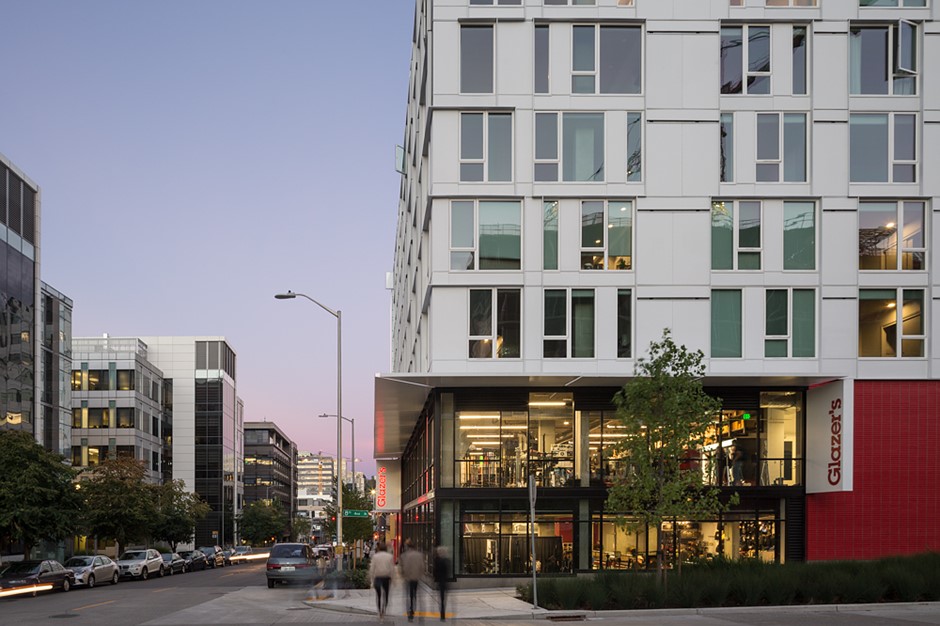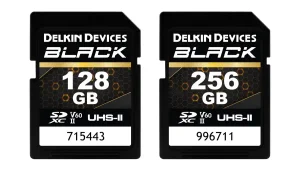
| Glazer’s Photo is a two-story photography shop near downtown Seattle with an extensive selection of gear. |
Especially when it comes to buying a hand-held, personal tool like a camera, there are some things you simply can’t learn from shopping online. That’s why we recently ventured to DPReview’s local camera shop, Glazer’s Camera in South Lake Union, Seattle, for a hands-on perspective on where the energy resides in today’s market, at least in North America. Glazer’s is a staple of the Seattle photography community, staging events and classes, and carries a wide array of gear; you can find every major brand represented here, even Leica.
During our visit, we sat down with Glazer’s Sales Manager Mike Estes to ask about the state of the industry as viewed from the front lines – by the people behind the display counter at an honest-to-goodness in-person camera store.
Q: What’s going on in the camera store world right now?
So, we’re seeing a lot of people transitioning from the DSLR market to the mirrorless market to get the newest equipment. We are also seeing a lot of people jumping brands. They come in with their DSLR equipment and they want to go to a new brand.
Most of that is really geared on their research. And when they come into the store, they have a pretty good idea of where they want to land, but we can help a little bit based on what they want to get out of the new equipment.
[Our sales are mainly shared] between the three majors, Sony and Nikon and Canon – Fuji[film] is a pretty good player with us as well. Sony had kind of owned the market for so long, and now we’re seeing their market share kind of being balanced out by Nikon and Canon.
Q: We’re seeing an industry trend where brands are saying they’re focused on content creators, and coming out with vlogging cameras. Is that actually bringing people into the store to check out these models?
A little bit, but it’s interesting. We’re seeing a lot of those type of shooters wanting to go up the line, not [buying] the entry-level vlogging cameras that do a little bit of everything. They’re really looking for a higher-end model, at least the people that come to our store.
 |
| Hybrid cameras are attractive to Glazer’s shoppers, according to Mike Estes. |
Q: Do camera buyers these days care about video or stills more?
We’re seeing that distinction [balance out] where a lot of people coming in now want to do both. And they really need one tool; they don’t want to buy two things. They want something that will let them, on a dime, just switch and start doing video or switch and start doing stills. So, the hybrid cameras have been very, very popular.
Q: About a decade ago, the perennial top-selling cameras were the cheapest dual-lens DSLR kits, where the user would never buy another lens. What does it look like for you now?
A lot of what we sell are single-lens kits or body only. People are wanting to upgrade from the standard second-lens kit and really pick their own second lens. We’ve been lucky in the last six months to see some new cameras coming out with really, really high-quality basic lenses. What we would normally term the kit lens, which is like a negative thing, have turned out to be some really nice lenses.
But we do sell an awful lot of body only, then help the buyer customize it based on what their needs are. People like the ability to try the lenses [in the store] and see what it’s really going to do. People coming in from shooting their phones don’t understand telephoto or macro lenses and how those would benefit them. So it’s a handy way to get them excited about other types of photography.
Q: I’m sure the pandemic was very hard for in-store sales. How are things picking up at Glazer’s?
Very good. We’re basically back to pre-pandemic numbers and volume. It was hard for a while with the manufacturers not being able to get us product. But our customers found us online when we were closed for a period of time during the beginning of the pandemic. We had a skeleton crew that was able to take care of ’em. But now, for the most part, the flow of product is really good and the customers want to get back shooting and want to be out and doing things.
Q: Do you notice any buying trends with the different age groups?
The younger crowd – under thirty – are really, really being driven in by film. We’re selling every film camera we can get our hands on. People are coming in with film cameras and wanting advice on how to use ’em, and they’re buying film, filters and stuff to create a film kit.
So that’s been really strong. And then the trend has gone completely away from the compact point-and-shoots to the interchangeable lens market. We sell a very, very small amount of compacts. Bridge cameras even have kind of died away. Mid-level interchangeable lens cameras I think are by far the most popular with people, even as young as twenty and younger.
I would say a small percentage are diehard DSLR shooters who don’t want to change. [But] we’re seeing the older group really looking at adopting the new technology to get better photos.
 |
| Estes says the X100V, which has been backordered for a while now, drives a lot of phone calls to the store. |
Q: What’s the one question you’re tired of hearing from customers?
‘Where are the X100Vs?’ [We get] calls and emails and people signing up. We have a tremendous backorder on that camera and people are calling every store trying to find it and they’re frustrated. We have been really focused on trying to find alternatives for those people because that camera is so hard to get.
I mean, there are people who have been waiting over a year, just waiting and waiting and hoping that the camera shows up. So it’s become a cult classic, as it were. It’s got this huge following. I mean, deservedly so – the camera’s amazing.
Q: What are customers buying in terms of camera accessories?
Tripods. A lot of tripods – people who have never used a tripod are trying new types of photography now that require them to have one. We’re seeing a lot of need for travel tripods too. Now that travel is back open, people want to take it with them. [They want something] to hold their gear and it’s small, so they can be in the image themselves or do long exposures, starscapes, things like that.
Q: How are you feeling about the future of the camera industry?
The feeling in the store really is pretty upbeat. I think we’re seeing a pretty nice resurgence with mirrorless. People are buying new gear and excited for new lenses and accessories and trying things that they’ve not tried before.
Many thanks to Mike Estes for taking the time to answer our questions.




